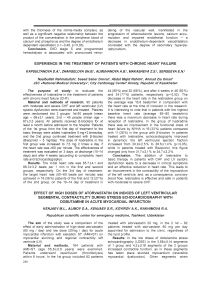Experience in the treatment of patients with chronic heart failure
Автор: Kapsultanova D.A., Zhangelova Sh.B., Almuhanova A.B., Makasheva Z.S., Sergeeva E.N., Saeed Saber Dimral, Abdul Majid Rahimi, Ahmad Zia Omari, Nasibullah Rahmatullah
Журнал: Евразийский кардиологический журнал @eurasian-cardiology-journal
Рубрика: Хроническая сердечная недостаточность
Статья в выпуске: S2, 2019 года.
Бесплатный доступ
To evaluate the effectiveness of Ivabradine in the treatment of patients with chronic heart failure (CHF).
Короткий адрес: https://sciup.org/143170249
IDR: 143170249
Текст статьи Experience in the treatment of patients with chronic heart failure
Material and methods of research. 95 patients with moderate and severe CHF and left ventricular (LV) systolic dysfunction were examined and treated. Patients were randomized into 2 groups: 1st-50 people (mean age – 69 ± 3,1 years), 2nd – 45 people (mean age – 67 ± 3,3 years). All patients received β-blockers for at least a month before admission to the hospital. Patients of the 1st group from the first day of treatment to the basic therapy were added Ivabradine 5 mg × 2 times/day, and the 2nd group continued treatment with β-blocker (Bisoprolol – 5 mg/day). The dose of Ivabradine in the first group was increased to 7,5 mg 2 times a day, if the heart rate was ≥60 per minute. The effectiveness of treatment was evaluated on 3 days, at discharge (10–14 days) and after 4 weeks (according to complaints, heart rate and Echocardiography).
Results. The initial heart rate was 85,7 ± 4,1 and 86,3 ± 3,2 beats per 1 min in the first and second groups, respectively. On the 3rd day of treatment, the target heart rate (50–60 beats per minute) was achieved in 18 (36 %) patients of the first and 12 (27 %) of the 2nd group, on the 10–14 day of treatment in
44 (89 %) and 30 (68 %), and after 4 weeks in 46 (92 %) and 34 (77 %) patients, respectively (p < 0,02). The decrease in the heart rate in the Ivabradine group on the average was 16,8 beats/min in comparison with the heart rate at the time of inclusion in the research. It is interesting to note that in patients with the highest baseline heart rate (average 85–90 beats/min) there was a maximum decrease in heart rate during reception of Ivabradine. In the group of Ivabradine there was an improvement in the functional class of heart failure by NYHA in 16 (33 %) patients compared with 11 (26 %) in the group with β-blocker. In patients treated with Ivabradine, echocardiography improved in dynamics: the left ventricular ejection fraction increased from 30,9 ± 2,5 % to 38,6 ± 1,4 % (p < 0,05), while in patients treated with Bisoprolol, this figure changed only from 31,7 ± 2,1 % to 34,7 ± 2,2 %.
Conclusion. The addition of Ivabradine to basic therapy in patients with CHF and LV systolic dysfunction leads to a decrease in clinical symptoms and an effective reduction in heart rate. This leads to an improvement in the contractility of the myocardium of the left ventricle, and, as a consequence, coronary blood flow. Ivabradine is effective and safe in patients with moderate to severe CHF.
EFFECT OF HIGH DOSES OF ATORVASTATIN ON INDICES OF LEFT VENTRICULAR SEGMENTAL CONTRACTILITY DURING STRESS ECHOCARDIOGRAPHY WITH DOBUTAMINE IN ACUTE MYOCARDIAL INFARCTION
KENJAEV M.L., ALIMOV D.A., KENJAEV S.R., KOYIROV A.K., RAKHIMOVA R.A.
Republican scientific center for emergency medicine, Tashkent. Uzbekistan
The aim of the study was a comparison of the effect of early administration of high-dose atorvastatin (80 mg / day) and low dose (20mg / day) for acute myocardial infarction with elevation ST (AMI+ST) on myocardial stunning and regional contractility left ventricle (LV).
Material and methods. 164 patients with AMI+ST (age 55,8 ± 0,6 years) were examined. Patients underwent reperfusion (thrombolysis) within 6 hours. In the 1st group included 82 patients 248
treated with atorvastatin 20 mg, in the 2 nd – 82 patients treated with atorvastatin 80 mg per day appointed for admission to the clinic, regardless of the lipid profile.
Results. In the low doses of dobutamine stress echocardiography (LDSE) in the 3,88 ± 0,14 segments of 1 group and 4,2 ± 0,16 segments of the 2 groups increased contractile function, as in these segments has taken place stunned myocardium (reversible myocardial dysfunction). Other segments when


